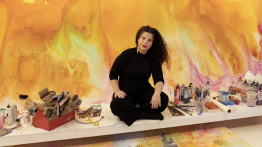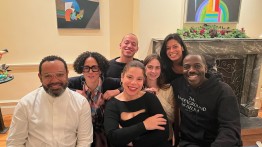Firelei Báez: Celebrated Artist and Alumna Returns to Cooper
POSTED ON: August 3, 2023
Last fall, 14 students in the School of Art studied with the celebrated artist and alumna Firelei Báez thanks to the Alex Katz Chair in Painting, a one-semester visiting professorship awarded to a distinguished artist from the fields of painting and drawing. Báez, who graduated from Cooper’s School of Art in 2004, has made a body of work that confronts the impact of colonial history on racial and gender identity. Exploding with saturated color and pattern, Báez’s canvases fuse living things—human bodies, plants, and animals—with the ephemera of colonialism—particularly maps. Female bodies, often shown in silhouette, sometimes stand barefoot and sometimes are tottering on front toes with the backs of their feet extended into the shape of a high heel, bodies literally conforming to the demands of gender.
The richness of her imagery was born of a desire to create a place for herself in a tradition that included few women of color. “I remember as a student being overwhelmed by the history of painting, especially Western painting,” she says. “I remember feeling that I wasn’t included in it. So I tried to really investigate every part of it in order to enter a space.”
She was able to share her critical intervention in that history with Cooper students through the visiting professorship established and underwritten by the celebrated painter Alex Katz, a 1949 School of Art graduate. One of the benefits afforded by the named position is to bring the best contemporary practitioners and a wide range of artistic perspectives to campus.
Báez grew up in Miami and knew nothing about The Cooper Union until, as she recalled at an artist’s talk last December, Professor Emerita Day Gleeson encouraged her to apply. “No one said it’s very rigorous, no one said very few people are accepted. They said: try.” That approach, one infused with both curiosity and diligence, underpins her work ethic. “I feel I’m always trying to learn more.” Báez was awarded The Cooper Union President’s Citation in 2022 and is the recipient of the Philip Guston Rome Prize and the Artes Mundi 9 Prize. Her work is held in significant collections, including the Baltimore Museum of Art, the Tate Modern, the Guggenheim Museum, the Whitney Museum of American Art, and the Studio Museum in Harlem, to name just a few.
As an artist fascinated with where and how knowledge is stored and accessed, Báez is drawn to archives, where she culls ship manifests, lists, and maps that often become part of her paintings. During a talk she gave at Cooper last December, Professor William Villalongo A’99 asked her how archives became so essential to her process, and she answered that it started while she was a student at Cooper. “There were free materials in the library, things that they had decided no longer fit the school’s needs.” While the books and journals themselves became materials for her art-making, they also prompted a set of questions: What stories do we hold on to? Which are discarded or updated? And what are the criteria?
School of Art alumnus Jairo Sosa A’17 recently said, “Firelei Báez has been a great inspiration for me because of the way she unearths and reinterprets buried histories through her alluring and challenging paintings and sculptures.” Like Báez, Sosa, a sculptor currently completing his M.F.A. at Columbia, makes work that depends upon archival references. “The rigorous research she conducts coupled with her intensive studio practice is what makes her works so spectacular—and inspirational.”







